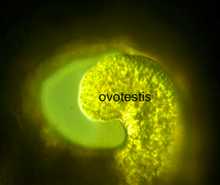Ovotestis
An ovotestis ( hermaphrodite or hermaphroditic gonad , also testovar) is a gonad (gonad) that combines the functions of the ovary ( ovary ) and testis ( testis ) and can therefore produce both egg cells and sperm . Most hermaphroditic animals have both ovaries and testes in an individual, the occurrence of hermaphroditic glands being the exception. However, they can be found in different groups of snails and in some sea squirts . Ovotestes can also occur as malformations in other animal species, including humans.
Hermaphrodites in snails

Hermaphrodites occur in the almost exclusively hermaphrodite heterobranchia (including hind gill snails ( Opisthobranchia) and pulmonate snails (Pulmonata)). The hybrid glands are depending on the type of individual to thousands of one or more lobes and this depending on the type and size of the animal acini , blind-ended, rounded or pear-shaped tubes within which the bacterial cells are formed, wherein the egg and sperm cells in different affinity groups either be formed in separate regions or distributed over the entire acinus. The two types of germ cells are often not formed at the same time, with proterandry (formation of sperm cells before egg cells) the rule and proterogyny the exception. This temporal separation also prevents self-fertilization .
Ovotestes as malformations
Ovotestes can appear as malformations in a variety of mammals, including humans, mice, and dogs. In true hermaphroditism (hermaphroditism verus), the anlage of the gonads does not develop into a pure ovary or testicle, but has tissue from both organs. Hermaphrodites with two gonosome X chromosomes usually have either one ovotestis and one ovary or two ovotestes, while hermaphrodites with one X and one Y chromosome have 75% one right testicle and one ovary or one ovotestis and only rarely two ovotestes . The portion of the ovarian and testicular tissue can be almost entirely on one side or somewhere in the middle.
proof
- ↑ Willibald Pschyrembel : Pschyrembel Clinical Dictionary . Edited by Helmut Hildebrandt, 258th edition. de Gruyter, Berlin 1998, ISBN 3-11-014824-2 , p. 1178
- ↑ Volker Storch, Ulrich Welsch: Short textbook of zoology . 7th edition. Gustav Fischer, Stuttgart, Jena, New York 1994, ISBN 3-437-20507-2 , pp. 256 .
- ^ Karl M. Wilbur, NH Verdonk, JAM van den Biggelaar: Reproduction . In: AS Tompa (ed.): The Mollusca . tape 7 . Academic Press, Orlando 2013, ISBN 978-0-08-092659-9 , pp. 51 .
- ↑ Genetics of Sex Determination . In: RS Verma (Ed.): Advances in Genome Biology . tape 4 . JAI Press, Middlesex 1996, ISBN 978-0-08-052617-1 , pp. 58 .